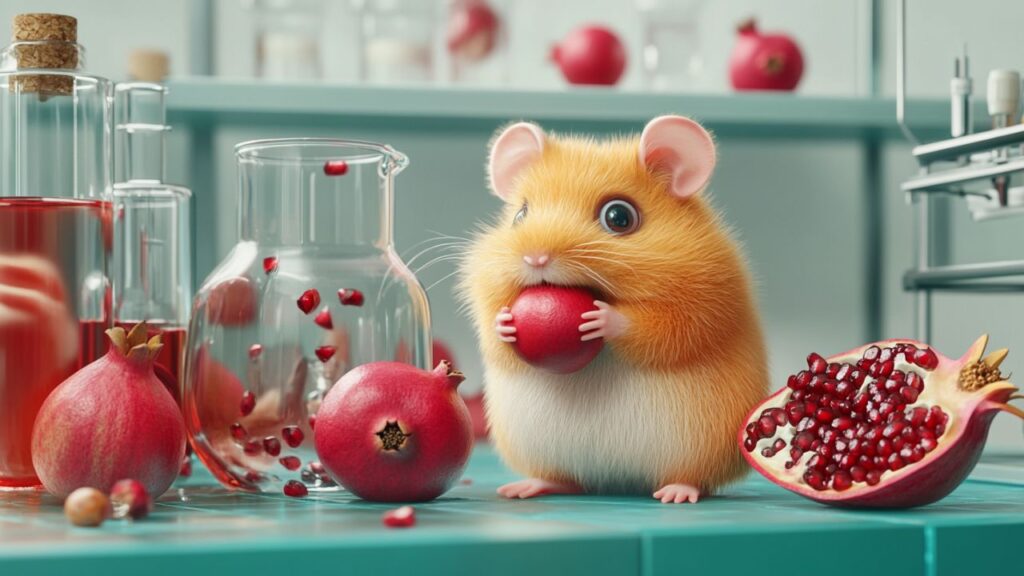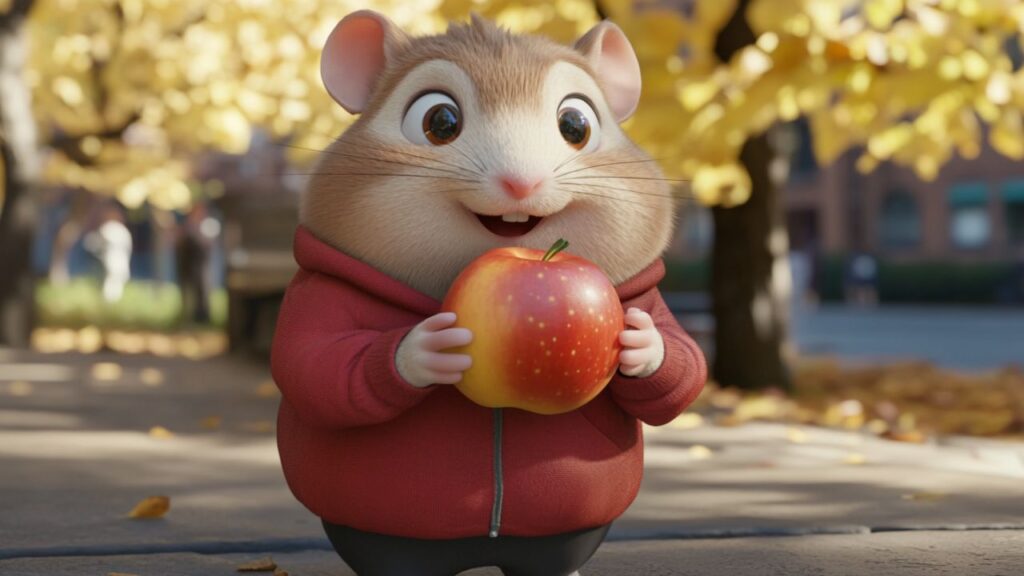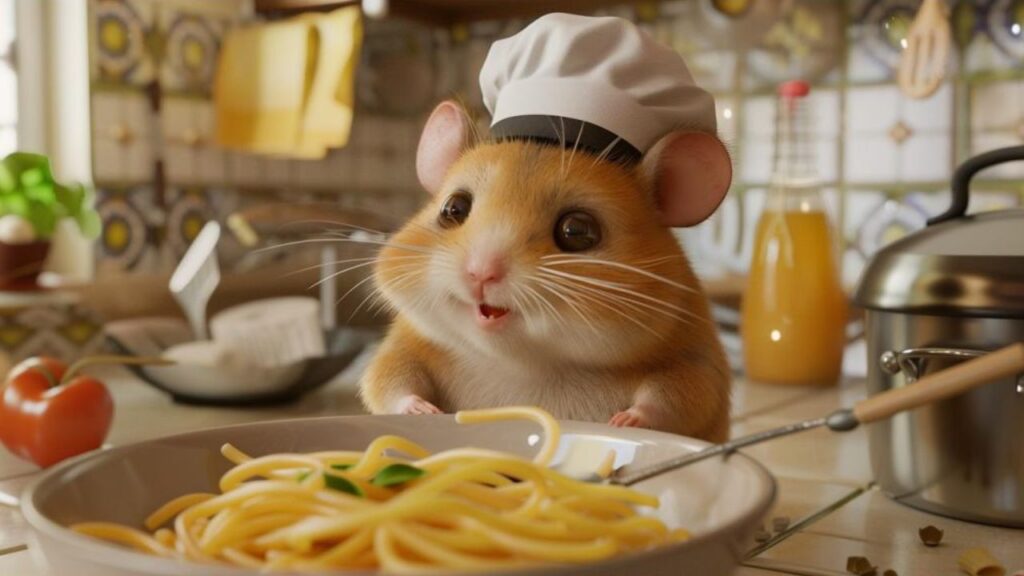TL;DR Summary
While pomegranates contain beneficial nutrients like vitamin C and antioxidants, they are not a recommended treat for hamsters. The high sugar content, acidity, and risk of choking on seeds can lead to health problems such as obesity, diabetes, and digestive issues. This is especially dangerous for Dwarf hamsters, who are particularly sensitive to sugar and prone to diabetes. If you want to offer a fruit treat, safer options include small portions of apple (without seeds), blueberries, or strawberries. Always prioritize moderation and consult your vet if you have concerns about introducing new foods.
When it comes to feeding your hamster, ensuring that their diet is balanced, safe, and nutritious is paramount. While the majority of a hamster’s diet should consist of high-quality hamster pellets, fresh water, and a few select vegetables, many pet owners wonder if they can spice up their little buddy’s menu with fruits like pomegranate. But is this vibrant and juicy fruit really suitable for hamsters? Let’s dive into the details!
Why Hamster Owners Might Consider Pomegranate
Pomegranates are often touted as a “superfood” for humans, thanks to their rich content of vitamins, antioxidants, and anti-inflammatory properties. It’s no surprise, then, that many hamster owners might think about offering a few seeds to their small, furry friends. After all, we want to provide the best for our pets, and it’s tempting to share nutritious foods we ourselves enjoy.
However, just because a fruit is healthy for us doesn’t mean it’s automatically safe for hamsters. These tiny animals have unique dietary requirements and delicate digestive systems that must be carefully managed. Pomegranate’s intense sweetness, acidity, and seed structure raise concerns about its safety and suitability for hamsters. This is why it’s essential to explore both the benefits and risks before deciding if pomegranate can become an occasional treat in your hamster’s diet.
The Balancing Act: Benefits and Risks of Pomegranate for Hamsters
Pomegranates do offer some potential health benefits for hamsters, such as vitamin C for immune health and antioxidants that may support overall well-being. However, the fruit’s high sugar content, acidic nature, and tough seeds can pose serious risks, especially for species that are prone to diabetes or digestive issues, such as Dwarf hamsters.
Nutritional Profile of Pomegranates: What’s Inside This Juicy Fruit?

Pomegranates are renowned for their dense nutritional content and health-boosting properties in humans, but how do these nutrients translate to our tiny hamster companions? Let’s take a closer look at what makes up this vibrant red fruit and how each component might impact a hamster’s health—both positively and negatively.
What Nutrients Are Found in Pomegranates?
Pomegranates are packed with a variety of essential nutrients that contribute to their superfood status. Here’s a breakdown of the key vitamins, minerals, and other nutritional components found in pomegranates:
- Vitamins:
- Vitamin C: Promotes a strong immune system and helps with the absorption of iron. It’s crucial for tissue repair and maintenance in all animals.
- Vitamin K: Important for proper blood clotting and bone health.
- Vitamin B5 (Pantothenic Acid): Supports healthy metabolism and energy production.
- Minerals:
- Potassium: Helps regulate fluid balance and muscle function.
- Magnesium: Plays a role in enzyme function and muscle relaxation.
- Calcium: Essential for bone health, though in much smaller quantities for hamsters than for humans.
- Antioxidants:
- Pomegranates are rich in antioxidants like polyphenols and flavonoids, which help neutralize free radicals and reduce oxidative stress in cells. This can contribute to overall well-being and potentially support longevity.
- Dietary Fiber:
- Helps with digestion and maintaining healthy gut flora, though too much fiber can cause bloating and digestive discomfort in hamsters.
- Natural Sugars:
- Pomegranates contain a high amount of natural sugars like fructose and glucose, which provide quick energy but can be dangerous in excess—especially for hamsters prone to diabetes.
The Theoretical Benefits of Pomegranate for Hamsters
The nutrients found in pomegranates offer a range of potential benefits for hamsters, if served in strict moderation. Here are a few examples of how the nutrients in pomegranate might support a hamster’s health:
- Immune System Boost: The high levels of vitamin C can help bolster a hamster’s immune system, making them more resistant to infections and illness. This is particularly beneficial for older hamsters or those recovering from minor ailments.
- Antioxidant Support: Antioxidants like polyphenols and flavonoids have been linked to reduced oxidative stress, which can help protect a hamster’s cells and tissues from damage. This might contribute to better overall health and a reduced risk of age-related issues.
- Digestive Health: A small amount of dietary fiber can aid in healthy digestion, keeping the hamster’s gastrointestinal system running smoothly and preventing constipation.
Potential Health Risks of Pomegranate for Hamsters
While pomegranates may offer some health benefits, their nutrient profile also raises several concerns when it comes to feeding them to hamsters:
- High Sugar Content: The natural sugars in pomegranates are far too concentrated for a hamster’s tiny body to process efficiently. Consuming too much sugar can lead to obesity, diabetes, and even dental problems. This is especially critical for dwarf hamster breeds like Campbell’s and Winter Whites, which are genetically predisposed to diabetes.
- Acidic Nature: Pomegranates are relatively high in acidity, which can cause stomach upset, diarrhea, and discomfort in hamsters if consumed in excess. Their small digestive tracts are sensitive, and highly acidic foods can disrupt their gut pH balance.
- Choking Hazard and Digestive Blockage: Pomegranate seeds are small and hard, making them a potential choking hazard for hamsters. Even if they manage to chew and swallow the seeds, they may struggle to digest them properly, which could lead to gastrointestinal blockages.
- Imbalanced Calcium-Phosphorus Ratio: The mineral content in pomegranates, particularly the calcium-phosphorus ratio, is not ideal for hamsters. A disproportionate ratio can contribute to bladder stone formation, especially in older hamsters.
Final Verdict on Pomegranate’s Nutritional Suitability
Given the combination of high sugar content, acidity, and potential choking hazards, it’s clear that pomegranate is not an ideal fruit for hamsters. While they may nibble on a tiny portion of the flesh occasionally, it’s best to avoid giving them the seeds, peel, or juice. The potential health risks far outweigh the benefits, and there are safer fruit options available that provide similar nutrients without the associated dangers.
Is Pomegranate Safe for Hamsters?

Before offering any new food to your hamster, it’s important to consider their unique dietary needs and sensitivities. While pomegranate might seem like a tempting treat given its vibrant color and sweet taste, it isn’t necessarily safe for every hamster. In fact, feeding pomegranate to your hamster can pose several health risks if not approached cautiously. Let’s explore these potential dangers and see how pomegranate affects different hamster species.
Potential Risks of Feeding Pomegranate to Hamsters
Pomegranates are known for their rich nutrient profile, but they also contain properties that may not sit well with your small, furry friend. Here are the key risks associated with feeding pomegranate to hamsters:
- High Acidity: Pomegranates have a fairly high acid content, which can upset the delicate balance of your hamster’s digestive system. Consuming acidic foods can lead to stomach pain, diarrhea, and general discomfort. For hamsters, whose digestive systems are designed to handle more neutral or slightly alkaline foods, the acidity of pomegranate could cause gastrointestinal irritation.
- High Sugar Content: Pomegranates are naturally sweet due to their high sugar content. While the occasional small fruit piece may not significantly affect a larger hamster, sugary foods can be harmful in excess. High sugar intake can cause weight gain, tooth decay, and even lead to diabetes. Dwarf hamsters, in particular, are highly prone to diabetes and should avoid sugary foods altogether.
- Choking Hazards and Digestive Blockages: Pomegranate seeds are small and hard, making them a serious choking hazard for hamsters. Even if the seeds are successfully chewed and swallowed, they can cause digestive blockages or internal damage due to their tough texture. This is especially dangerous for smaller species like Roborovski and Dwarf hamsters, whose digestive systems are more delicate.
- Imbalanced Nutrient Ratios: Pomegranate’s calcium-to-phosphorus ratio is not ideal for hamsters. When fed regularly or in large amounts, this imbalance can contribute to issues such as bladder stones and poor bone health over time.
Different Hamster Species and Their Sensitivities
Not all hamster species respond to the same foods in the same way. It’s essential to understand the unique dietary sensitivities of your hamster’s species before introducing any new treat, including pomegranate.
1. Syrian Hamsters:
Syrian hamsters are the largest and most robust of the commonly kept pet hamster species. They tend to have stronger digestive systems compared to their smaller cousins, which means they can tolerate a wider variety of foods in small amounts. While it’s still not advisable to make pomegranate a regular part of a Syrian hamster’s diet, a tiny portion of the soft, inner flesh (no seeds!) can occasionally be offered as a rare treat. However, it’s best to monitor for any signs of digestive upset afterward.
2. Roborovski Hamsters:
Roborovski hamsters, also known as “Robo” hamsters, are much smaller and more sensitive than Syrians. Due to their petite size, they are more susceptible to digestive issues and can quickly become overwhelmed by sugary or acidic foods. Pomegranate is not recommended for Roborovski hamsters because the risks—such as potential digestive irritation or nutritional imbalance—greatly outweigh any perceived benefits.
3. Dwarf Hamsters (Campbell’s, Winter White, and Chinese):
Dwarf hamsters, including Campbell’s, Winter Whites, and Chinese hamsters, have a genetic predisposition to diabetes and other metabolic disorders. Their small bodies cannot handle sugary or acidic foods like pomegranate without a heightened risk of adverse effects. Even a small amount of pomegranate flesh can elevate their blood sugar levels dangerously, so it’s best to avoid offering this fruit to Dwarf hamsters altogether.
Are Pomegranate Seeds, Peel, and Juice Safe for Hamsters?
Different parts of the pomegranate present varying levels of risk for hamsters. Here’s a quick guide to the safety of the seeds, peel, and juice:
- Pomegranate Seeds: Definitely a no-go for hamsters. The seeds are hard and pose a significant choking hazard. Even if chewed, they can be difficult to digest and may cause internal damage or blockages.
- Pomegranate Peel: The peel is not suitable for hamsters as it contains tannins and other compounds that can be harmful if ingested. It’s also quite tough and fibrous, making it difficult to chew and digest.
- Pomegranate Juice: While pomegranate juice might seem like a safer option since it doesn’t contain the solid parts of the fruit, it is highly concentrated and acidic. A few drops of juice could upset your hamster’s stomach or spike their blood sugar levels, so it’s best to avoid giving your hamster any pomegranate juice.
Is Pomegranate Safe for Hamsters?
In summary, pomegranate is not a recommended food for hamsters. While larger Syrian hamsters may nibble on a small piece of the soft inner flesh as an occasional treat, it’s best to avoid feeding this fruit to Roborovski or Dwarf hamsters altogether. The high sugar content, acidity, and risk of choking or digestive issues make pomegranate more problematic than beneficial for these small pets.
If you’re looking to offer your hamster a fruity treat, consider safer options like apples (without seeds), blueberries, or strawberries, all of which have a milder nutritional profile and pose fewer health risks.
Potential Benefits of Pomegranate for Hamsters

Despite its risks, pomegranate does contain certain nutrients that could theoretically provide health benefits to hamsters if consumed in very small, controlled amounts. As with many human “superfoods,” the vibrant red fruit is packed with vitamins, antioxidants, and other beneficial compounds that might seem like a healthy addition to a hamster’s diet. But before getting too excited about these potential perks, it’s crucial to weigh them against the possible dangers.
In this section, we’ll discuss the potential benefits of pomegranate for hamsters and why, despite these advantages, pomegranate is best offered sparingly—if at all.
Antioxidants: Boosting the Immune System and Fighting Free Radicals
Pomegranates are well-known for their high antioxidant content, which includes polyphenols, flavonoids, and anthocyanins. Antioxidants play a vital role in neutralizing free radicals—unstable molecules that can cause oxidative stress and damage cells. For hamsters, as with humans, antioxidants are believed to help reduce the risk of chronic diseases and support overall well-being.
In hamsters, antioxidants can theoretically:
- Enhance Immune Function: A diet rich in antioxidants could help bolster a hamster’s immune system, making them more resilient to infections and environmental stressors. This is particularly important for older hamsters or those who may be recovering from minor illnesses.
- Promote Cellular Health: By reducing oxidative damage, antioxidants can protect cells and tissues from wear and tear. This may contribute to better organ function and longevity.
- Support Heart Health: Some studies on small mammals suggest that antioxidants can promote cardiovascular health by reducing blood pressure and supporting healthy blood flow.
Vitamin C: Supporting Immune and Tissue Health
Pomegranates are a rich source of vitamin C, an essential nutrient for maintaining a healthy immune system and promoting tissue growth and repair. While hamsters can produce their own vitamin C, additional amounts through diet may offer extra immune support, particularly in times of stress or illness.
Potential Benefits of Vitamin C for Hamsters:
- Stronger Immune Defense: An enhanced intake of vitamin C can lead to a stronger immune response, helping hamsters fight off infections more effectively.
- Tissue Repair and Maintenance: Vitamin C is essential for the synthesis of collagen, a key structural protein that supports skin, cartilage, and blood vessels. Adequate collagen production helps keep a hamster’s body in good shape, promoting quicker recovery from injuries and maintaining overall vitality.
Dietary Fiber: Promoting Healthy Digestion
Pomegranates contain a moderate amount of dietary fiber, which is beneficial for digestive health when consumed in the right quantities. Fiber can aid in maintaining healthy gut flora, promoting smooth digestion, and preventing constipation.
Potential Benefits of Fiber for Hamsters:
- Improved Digestion: A small amount of fiber can help prevent gastrointestinal issues such as constipation or diarrhea by supporting regular bowel movements.
- Gut Health: Fiber acts as a prebiotic, feeding the good bacteria in a hamster’s gut. This contributes to a healthy balance of gut flora, which is important for nutrient absorption and overall health.
Phytochemicals: Reducing Inflammation and Supporting Brain Health
Pomegranates are also rich in phytochemicals, naturally occurring compounds that have been studied for their potential anti-inflammatory and neuroprotective effects. In small animals, such as laboratory mice, certain phytochemicals have shown promise in reducing inflammation and supporting cognitive health.
Potential Benefits of Phytochemicals for Hamsters:
- Anti-Inflammatory Properties: Phytochemicals may help reduce inflammation in the body, which is particularly beneficial for older hamsters suffering from arthritis or other age-related conditions.
- Neuroprotective Effects: These compounds have been linked to improved brain health and cognitive function in rodents, which may, in theory, contribute to better mental sharpness and memory retention in hamsters.
Why the Potential Benefits Might Be Outweighed by the Risks
While the nutrients in pomegranates could provide certain health benefits to hamsters, these benefits are significantly overshadowed by the fruit’s inherent risks. Here’s why:
- High Sugar Content: The sugar content in pomegranates is simply too high for a hamster’s diet. Excess sugar can lead to obesity, tooth decay, and diabetes—especially in Dwarf hamsters, who are already predisposed to such metabolic disorders. No matter how beneficial the fruit’s other nutrients might be, the danger posed by its sugar levels is too great to ignore.
- Acidity and Digestive Sensitivity: Pomegranates are acidic, which can irritate a hamster’s digestive tract, leading to upset stomach, diarrhea, or general discomfort. The potential for these adverse reactions diminishes any benefit that might be gained from the fruit’s vitamins or antioxidants.
- Choking and Digestive Blockage Hazards: Pomegranate seeds are hard and difficult for hamsters to chew and digest. Even if the seeds are broken down, they can cause internal blockages or injuries, making them a dangerous addition to your pet’s diet.
- Imbalanced Nutritional Ratios: The overall calcium-to-phosphorus ratio and other nutrient imbalances in pomegranates make them unsuitable as a regular dietary component for hamsters. These imbalances can lead to long-term health issues, such as bladder stones or weakened bones.
Alternatives to Pomegranate: Safer Fruit Options for Your Hamster

While pomegranates may offer some health benefits in theory, they present more risks than rewards for your tiny hamster friend. Fortunately, there are plenty of other fruits that are not only safer but also easier to incorporate into your hamster’s diet. These hamster-friendly fruits offer similar nutritional perks—such as vitamins, fiber, and antioxidants—without the high sugar content, acidity, or choking hazards associated with pomegranates.
In this section, we’ll explore a few of the best fruit alternatives for hamsters, comparing their nutritional profiles with that of pomegranates and highlighting why they’re superior options for your pet.
1. Apple (Without Seeds or Core)
Apples are a popular and hamster-safe fruit that can be offered in small, bite-sized pieces. They provide a sweet, juicy treat that hamsters love, and their nutritional profile is far less risky than that of pomegranates.
Nutritional Comparison:
- Lower Sugar Content: Apples contain natural sugars like fructose, but in lower amounts than pomegranates. This makes them less likely to cause spikes in blood sugar levels or contribute to obesity.
- Vitamins and Minerals: Apples are a good source of vitamin C and contain smaller amounts of vitamin A, potassium, and dietary fiber. While they lack the antioxidant variety of pomegranates, they still offer immune-boosting and digestive benefits.
- Less Acidity: Apples have a more neutral pH level compared to pomegranates, making them gentler on a hamster’s digestive system.
Feeding Guidelines: Offer a small, thin slice of apple, making sure to remove any seeds and the core, as these parts contain cyanogenic compounds that are toxic to hamsters.
2. Blueberries
Blueberries are another excellent fruit choice for hamsters. They’re packed with antioxidants and other beneficial nutrients, but their sugar and acidity levels are much more manageable compared to pomegranates.
Nutritional Comparison:
- Antioxidant Power: Blueberries are well-known for their high antioxidant content, similar to pomegranates, but without the same level of risk. They contain flavonoids and polyphenols that support cellular health and may help protect against disease.
- Lower Sugar and Acidity: Although blueberries are sweet, they contain far less sugar and acidity than pomegranates, reducing the risk of digestive upset or blood sugar spikes.
- Small, Soft Texture: Blueberries are naturally small and soft, making them easy for hamsters to chew and digest. There’s no need to worry about choking hazards or digestive blockages.
Feeding Guidelines: Offer one or two small blueberries once or twice a week. Due to their sugar content, even these should be given in moderation, particularly for Dwarf hamsters.
3. Banana
Bananas are a hamster-safe fruit option that provides a creamy texture and a natural sweetness that most hamsters find irresistible. They’re loaded with nutrients but should be fed sparingly due to their higher carbohydrate content.
Nutritional Comparison:
- Rich in Potassium: Bananas are a great source of potassium, which helps regulate muscle function and fluid balance in the body. This can be beneficial for active hamsters who are always on the go.
- High in Fiber: The fiber content in bananas can support digestive health, but too much could lead to bloating or constipation in hamsters.
- Moderate Sugar Levels: Although bananas are lower in sugar than pomegranates, they still contain more carbohydrates compared to other fruits like apples or berries. Moderation is key to avoiding unwanted weight gain or blood sugar issues.
Feeding Guidelines: Provide a small, thin slice or a few small pieces of banana as an occasional treat. Avoid overfeeding due to the fruit’s high starch and sugar content.
4. Strawberry
Strawberries are another sweet, yet low-risk fruit that hamsters can enjoy in small quantities. Their high water content and array of vitamins make them a refreshing treat that’s much easier on a hamster’s digestive system compared to pomegranate.
Nutritional Comparison:
- Low Calorie and Low Sugar: Strawberries are naturally low in calories and sugar, making them a safer option for hamsters, particularly those prone to obesity or diabetes.
- High Vitamin C Content: Like pomegranates, strawberries are rich in vitamin C, supporting a healthy immune system and promoting skin and tissue health.
- High Water Content: The high water content in strawberries helps keep hamsters hydrated, especially in warmer months, but too much can cause loose stools if overfed.
Feeding Guidelines: Offer a small, diced piece of strawberry once a week. Make sure to wash the fruit thoroughly to remove any pesticides or chemicals.
5. Pear (Without Seeds or Core)
Pears are a juicy, sweet fruit that hamsters can eat in moderation. They provide a similar texture and taste to apples but with even lower acidity and a gentler impact on the digestive system.
Nutritional Comparison:
- Low Acidity: Pears have a very low acid content compared to pomegranates, making them a safer choice for hamsters with sensitive stomachs.
- Good Source of Dietary Fiber: Pears are rich in dietary fiber, which can support smooth digestion and prevent gastrointestinal issues.
- Moderate Sugar Content: While pears are sweet, they still have a lower sugar content than pomegranates, reducing the risk of blood sugar spikes.
Feeding Guidelines: Give your hamster a small slice of pear (about the size of a raisin), ensuring that all seeds and the core are removed.
Why These Fruits Are Better Than Pomegranates
Compared to pomegranates, these alternative fruits provide a safer balance of nutrients without the high sugar, acidity, or choking risks. While pomegranate’s antioxidants and vitamins are certainly beneficial, they’re overshadowed by the potential for adverse reactions like digestive upset or spikes in blood sugar. The fruits listed above offer similar health benefits with fewer risks, making them ideal occasional treats for your hamster.
Whisker Tips: Practical Advice for Feeding Fruits to Hamsters

Feeding fruits to your hamster can be a delightful way to add variety to their diet and boost their overall nutrition, but it’s essential to do so with care and consideration. Hamsters have tiny stomachs, unique dietary needs, and sensitive digestive systems, so introducing new fruits requires a thoughtful approach. In this Whisker Tips section, we’ll provide practical advice to help you safely incorporate fruits into your hamster’s diet, maintain proper diet balance, and address picky eating behaviors.
1. Start Small and Introduce New Fruits Gradually
When introducing a new fruit to your hamster’s diet, it’s important to take it slow. Just like humans, hamsters may need time to adjust to new foods, and introducing them too quickly can cause digestive upset. Here’s how to get started:
- Introduce One Fruit at a Time: Start by offering a tiny piece of a new fruit, no larger than the size of a raisin. This allows you to observe your hamster’s reaction and check for any signs of digestive issues or allergies, such as diarrhea, bloating, or changes in behavior.
- Wait and Observe: After introducing a new fruit, wait for 24–48 hours before offering it again. Monitor your hamster for any adverse reactions, and discontinue feeding the fruit if any symptoms arise.
- Gradual Increase: If your hamster shows no signs of discomfort or adverse effects, you can gradually increase the portion size. However, remember that fruits should only make up a small part of your hamster’s overall diet, typically no more than 5–10% of their total food intake.
Whisker Tip: Always wash fruits thoroughly before feeding them to your hamster. This removes pesticides, chemicals, and potential bacteria that could harm your pet.
2. Prioritize a Balanced Diet
Hamsters are omnivores and need a balanced diet to thrive. Their primary diet should consist of high-quality commercial hamster pellets, supplemented with fresh vegetables, and occasional fruits. Here’s how to ensure that your hamster’s diet is well-rounded and healthy:
- Limit Fruit Intake: Fruits should be given as treats, not as a main food source. Overfeeding fruits can lead to health problems like obesity, diabetes, and digestive issues. Stick to offering small fruit portions 1–2 times a week.
- Choose Nutrient-Dense Options: Opt for fruits that provide beneficial nutrients without excessive sugar or acidity. Berries (blueberries, strawberries), apples (without seeds), and small banana pieces are excellent choices.
- Incorporate Fresh Vegetables: Vegetables should be a staple in your hamster’s diet. Include leafy greens like spinach, kale, or romaine lettuce, as well as crunchy veggies like carrots, broccoli, or cucumber. These foods provide fiber and essential nutrients without the sugar content of fruits.
Whisker Tip: Rotate different fruits and vegetables to provide a variety of nutrients. This prevents boredom and ensures that your hamster gets a broad spectrum of vitamins and minerals.
3. Understand Your Hamster’s Species-Specific Needs
Not all hamsters are the same! Different hamster species have varying dietary needs and tolerances, particularly when it comes to sugary foods like fruits.
- Syrian Hamsters: As the largest of the pet hamster species, Syrian hamsters can handle a slightly larger variety of fruits and vegetables. However, moderation is still key. They may enjoy occasional treats of apple, banana, or berries without significant risk, provided it’s done sparingly.
- Roborovski Hamsters: Roborovski hamsters, or “Robos,” are smaller and more sensitive than Syrians. Their small size means that even tiny amounts of sugary or acidic foods can affect them. Stick to the smallest portions of fruit (no more than the size of a pea), and limit fruit intake to once a week or less.
- Dwarf Hamsters (Campbell’s, Winter Whites, and Chinese Hamsters): Dwarf hamsters are especially prone to diabetes and obesity. Because of their metabolic sensitivity, it’s best to offer fruits only occasionally and in minuscule portions. Safer options include berries or small apple slices. Avoid fruits with higher sugar content, like bananas or grapes, altogether.
Whisker Tip: If you’re unsure about a specific fruit or have concerns about your hamster’s health, consult a veterinarian for personalized advice based on your hamster’s species and condition.
4. Handle Picky Eating Behaviors
Hamsters, like people, can have unique food preferences and may show picky eating behaviors. It’s not uncommon for a hamster to nibble on one type of fruit and completely ignore another. Here’s how to handle picky eating and ensure they’re still getting a balanced diet:
- Introduce New Fruits Slowly: Sometimes, picky eating is simply a result of your hamster not being familiar with the new food. Give them time to get accustomed to the taste and texture of different fruits by offering a small piece repeatedly over several days.
- Mix Fruits with Favorite Veggies or Pellets: If your hamster is reluctant to try a new fruit, try mixing a tiny piece of it with a favorite vegetable or a small amount of their regular hamster food. This encourages them to taste the new food while still enjoying familiar flavors.
- Don’t Overdo It: Avoid offering multiple new foods at once. Hamsters can be overwhelmed by too many choices and may refuse everything. Stick to introducing one new fruit or vegetable at a time and only add a new item once they’re comfortable with the previous one.
Whisker Tip: Avoid force-feeding or “sneaking” fruits into your hamster’s food. If your hamster repeatedly refuses a certain fruit, it’s okay! There are plenty of other healthy options to choose from that they might prefer.
5. Monitor for Health Changes and Adjust Diet Accordingly
Always pay close attention to your hamster’s behavior, physical condition, and stool after introducing any new food. Changes in stool consistency, unusual lethargy, or excessive thirst can be signs that a particular fruit doesn’t agree with your hamster’s system.
- Check for Digestive Issues: Soft stool or diarrhea after eating a new fruit is a sign that it’s not suitable for your hamster. Stop feeding that fruit immediately and return to their regular diet until their digestive health stabilizes.
- Watch for Weight Gain: Sudden weight gain can indicate that you’re offering too many treats or high-calorie foods. Adjust their diet by reducing fruit intake and focusing on fiber-rich vegetables instead.
- Regular Health Check-Ups: Schedule regular check-ups with a veterinarian to ensure that your hamster’s diet is meeting their nutritional needs and that they’re maintaining a healthy weight.
Conclusion

Feeding your hamster a balanced and nutritious diet is essential for their long-term health and well-being. While it’s tempting to share fruits like pomegranate with your furry friend, it’s crucial to understand the potential risks and benefits before doing so. Pomegranates are packed with vitamins, antioxidants, and fiber that can theoretically support a hamster’s health, but the high sugar content, acidity, and choking hazards present significant dangers that make them less-than-ideal treats for these tiny pets.
Key Takeaways on Feeding Pomegranate to Hamsters
- Nutritional Profile and Potential Benefits: Pomegranates contain valuable nutrients such as vitamin C, antioxidants, and dietary fiber that could theoretically boost a hamster’s immune system, support digestion, and contribute to overall cellular health. However, these benefits can only be reaped if the fruit is fed in very small amounts, and even then, the risks often outweigh the potential advantages.
- Risks to Consider: High sugar content, acidity, and hard seeds make pomegranates problematic for hamsters. Consuming too much sugar can lead to obesity and diabetes, particularly in Dwarf hamsters, who are genetically predisposed to these conditions. The acidity of the fruit can cause digestive upset, and the seeds pose a serious choking hazard or risk of internal damage.
- Species-Specific Considerations: Different hamster species have varying tolerances to fruits and sugary foods. While Syrian hamsters might handle a tiny amount of pomegranate flesh as a rare treat, Roborovski and Dwarf hamsters should avoid it entirely due to their sensitivity to sugar and potential for digestive issues.
- Safer Alternatives: If you’re looking to add a bit of variety to your hamster’s diet, consider offering safer fruits like apples (without seeds), blueberries, or bananas in moderation. These fruits provide similar nutrients without the same level of health risks associated with pomegranates.
- Moderation is Key: If you decide to offer pomegranate to your hamster, it should be done very sparingly. Start with a tiny piece of the soft, inner flesh, and always monitor your pet for any adverse reactions. Remember that fruits should never constitute more than 5–10% of your hamster’s diet and should only be given as an occasional treat.
Understanding Your Pet’s Unique Needs
Every hamster is different, and their dietary needs will vary based on their species, age, health status, and individual preferences. Always consider your hamster’s unique needs when introducing new foods to their diet. If you’re ever in doubt about whether a certain food is safe, it’s best to consult your veterinarian for professional guidance.
In conclusion, while pomegranates might offer some nutritional benefits, the potential health risks for hamsters far outweigh these advantages. There are plenty of other safe, hamster-friendly fruits you can offer to keep your pet happy and healthy. By sticking to a well-balanced diet, monitoring portion sizes, and understanding your hamster’s specific dietary sensitivities, you can ensure that your furry friend leads a vibrant and healthy life.




